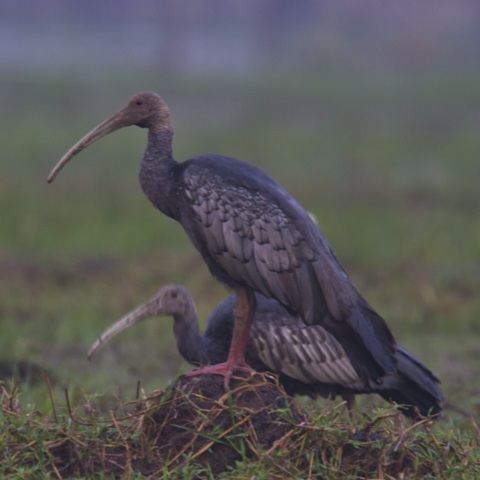Conservation Actions
Conservation Actions UnderwayCITES Appendix I. It has been protected under Indonesian law since 1972. The species was included in a status survey and 2000-2004 conservation action plan for Megapodes. Nesting ground surveys were made in North, Central and South East Sulawesi between 1990 and 2000. Over 50% of known nesting grounds (chiefly inland sites) are located inside protected areas, the most important being Lore Lindu National Park, Morowali Nature Reserve, and Bogani Nani Wartabone National Park. Effective conservation programmes have been implemented at the Tambun and Hungayono nesting grounds, where hatchery projects and improved guard patrolling have led to greatly increased hatching rates, at Taima (Libuun) near Tompotika in Central Sulawesi, and at the Pakuli/Saluki complex at Lore Lindu and the Tanjung Matop near Toli-toli (D. Neville in litt. 2004, M. Summers in litt. 2006). At the nesting ground in Libuun, Tompotika, Central Sulawesi, the Alliance for Tompotika Conservation (AlTo) has partnered with the village of Taima since 2006 to provide year-round protection for Maleos (M. Summers in litt. 2012). The project employs teams of permanent local staff and villagers to guard the nesting ground and record data. AlTo also provides community benefits to the village for its participation in the project, as well as an ongoing Outreach and Awareness campaign promoting Maleo conservation in schools and villages throughout the Tompotika area and in the city of Luwuk, where it has received government endorsement. Since the project began in 2006, all poaching has essentially ended at Libuun, and the number of adult Maleos returning to the nesting ground to lay has tripled; often during the high season more than 30 birds are present at a time. Another project in the Tangkoko-DuaSaudara Nature Reserve is run by the Tangkoko Ecotourism Guides Club, and involves the clearing of dense secondary growth, replanting of trees, and the re-establishment and monitoring of a viable nesting population (van As 2007). In May 2007, work by the Wildlife Conservation Society and Bogani Nani Wartabone National Park on the management of three nesting grounds saw the facilitated hatching and release of their 4,000th chick (Tasirin 2007), while the release of the 5,000th was expected in 2009 (WCS 2009). In 2009, it was reported that a 14-ha stretch of beach had been purchased by Pelestari Alam Liar dan Satwa (PALS: Wildlife and Wildlands Conservation), with the assistance of the Wildlife Conservation Society and external donors, to protect a nesting area for the species (WCS 2009).
Conservation Actions Proposed
Strengthen the capacity of conservation agencies and government to prevent illegal activities in formally protected areas and establish new management plans to realistically address conservation issues in national parks and nature reserves. Prioritise the protection of active and threatened nesting grounds over translocation of eggs to recolonise abandoned nesting grounds, which has been successfully implemented at some sites and should remain a tool for the future. Keep nesting grounds free from predators, human disturbance and invasive vegetation, and reforest adjacent areas (Gorog et al. 2005). Extend protected area status to forest corridors connecting nesting grounds and non-breeding areas. Expand management activities in protected areas, particularly scrub clearance at nesting sites. Initiate Maleo-based conservation activities in Paluki and Saluki, Central Sulawesi. Renew community-based protection initiatives. Monitor the effectiveness of hatcheries and other conservation measures and optimize egg protection strategies. Monitor daily numbers of birds laying at as many colonies as possible. Conduct more intensive research to establish its distribution and the extent of gene flow between nesting grounds. Conduct a Sulawesi-wide awareness-raising campaign to discourage Maleo egg consumption and use the species as a flagship for forest conservation.
Location Information
Macrocephalon maleo is endemic to Sulawesi and Buton Islands, Indonesia (Prawiradilaga 1997, Dekker et al. 2000, BirdLife International 2001). Of 149 nesting grounds considered to be active within the past three generations (since 1983), only 47 are currently considered active (Summers et al. in prep.). At least 33 additional sites have become abandoned but the timing is uncertain (M. Summers in litt. 2021). Consequently the species is suspected to have been lost from significant parts of the previously occupied range. The rapid decline was already noted by the start of the 2000s (Butchart & Baker 2000, Baker 2002, Gorog et al. 2005). On Buton, the three occupied sites are all at risk of abandonment (Froese & Mustari 2019).Remaining strongholds of the population are the Bogani landscape (incorporating Bogani-Nani Wartnabone National Park and surrounding forested areas), where conservation interventions have stabilised numbers at some nesting grounds (H. Bashari in litt. 2021) and at Tompotika, Central Sulawesi numbers have increased in recent years due to community-based conservation (Tasirin et al. 2021).
Geographic Range
Extant
Indonesia
Population Information
The total population is estimated to number 4,000-7,000 breeding pairs (Butchart & Baker 2000), equivalent to 8,000-14,000 mature individuals or 12,000-21,000 individuals in total. Despite numerous research projects at multiple nesting grounds since, a coordinated resurvey has only recently been undertaken which initial findings appear to confirm the continuation of a rapid decline (Alliance for Tompotika Conservation 2018).Very few nesting sites are considered secure: intact, connected to forest habitat and safe from egg collection (Dekker 1990). Where there is long-term conservation commitment numbers of individuals can increase rapidly: at TaimaThe key areas holding the largest proportions of the population are the 'Bogani Landscape' around Bogani Nani Wartabone National Park plus Tanjung Dako and Tanjung Matop areas along the coast in North Sulawesi (Argeloo 1994, Butchart & Baker 2000, Gorog et al. 2005), while in Central Sulawesi key sites are Lore Lindu National Park (Butchart & Baker 2000), Morowali Nature Reserve and nearby Sungai Bosu, and three sites on the eastern peninsular (Bakiriang, Libuun and Pintu Kubur) in Central Sulawesi (Butchart & Baker 2000).
Most information pertains to sites in the 'Bogani Landscape' in North Sulawesi. Here, 50% of known nesting grounds (18/36) were assessed as having been abandoned by 2003, and five of the 27 sites also assessed in 1990-1991 had been active at that time (Gorog et al. 2005). Six further nesting grounds were predicted to have a high likelihood of abandonment in the near future (Gorog et al. 2005). One of these sites, Tanjung Binereang, has been the subject of a significant conservation project involving the creation of a private locally-owned reserve that has been successful at preventing abandonment (Clements 2009). Sites within protected areas were more likely to persist and in the absence of direct intervention through guarding the nesting grounds abandonment was likely: 17/26 nesting grounds in non-protected areas assessed in 2003 had already been abandoned and of the remainder 6 were 'Severely Threatened' and two (adjacent to each other) were threatened (Gorog et al. 2005).
Numbers of individuals is difficult to assess, as pairs arrive intermittently at the breeding ground and females lay their estimated annual clutch of 8-12 eggs (Dekker 1990) over a variable time period. At Saluki, one of the main nesting grounds in Lore Lindu National Park, 162 mature individuals were estimated from maximum monthly number of eggs laid during a 6-month study in 2015, contrasted with an estimate of 325-650 for the site in 2001 (Yanto Samana 2015). However Butchart & Baker (2000) roughly estimated 10-50 pairs at the site in 2000, 20-100 mature individuals. Both works indicate a strong decrease has occurred, evidenced by the dramatic reduction in numbers of eggs harvested from over 30 daily in the early 1980s to only 1-2 a day by 1999 (Butchart & Baker 2000). Action to conserve this population has clearly prevented the abandonment of the site (Yanto Samana 2015).





